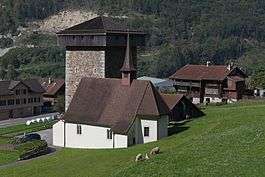Silenen
| Silenen | ||
|---|---|---|
 | ||
| ||
 Silenen | ||
|
Location of Silenen  | ||
| Coordinates: 46°47′N 8°40′E / 46.783°N 8.667°ECoordinates: 46°47′N 8°40′E / 46.783°N 8.667°E | ||
| Country | Switzerland | |
| Canton | Uri | |
| District | n.a. | |
| Area[1] | ||
| • Total | 144.77 km2 (55.90 sq mi) | |
| Elevation | 510 m (1,670 ft) | |
| Population (Dec 2015[2]) | ||
| • Total | 2,108 | |
| • Density | 15/km2 (38/sq mi) | |
| Postal code |
6473 Silenen 6474 Amsteg 6475 Bristen | |
| SFOS number | 1216 | |
| Localities | Bristen, Amsteg | |
| Surrounded by | Disentis/Mustér (GR), Erstfeld, Gurtnellen, Linthal (GL), Schattdorf, Spiringen, Tujetsch (GR), Unterschächen | |
| Website |
www SFSO statistics | |
Silenen is a municipality in the canton of Uri in Switzerland.
Geography
Silenen municipality comprises the villages of Silenen (divided into three parts, Dörfli, Russ, Rusli), Amsteg, and Acherli, besides numerous smaller hamlets or dispersed settlements, including Schützen, Buechholz, Öfibach, Dägerlohn, Frentschenberg, Ried (Vorderried, Hinterried), Maderanerthal valley (St. Anton = Vorderbristen, Bristen = Hinterbristen, Cholplatz, Hälteli, Steinmatte, Schattigmatt etc.), Hofstetten, Silblen, and the Golzeren plateau (Egg, Hüseren, Seewen, etc.)

Silenen has an area, as of 2006, of 144.8 km2 (55.9 sq mi). Of this area, 12.8% is used for agricultural purposes (mostly alpine pastures), while 18.3% is forested. Of the rest of the land, 0.7% is settled (buildings or roads) and the remainder (68.1%) is non-productive (mostly mountainous).[3][4]
Arnisee can be reached by gondola lift from Amsteg.
The Zwing Uri Castle, overlooking Amsteg has some importance in Swiss historiography as the first fortress destroyed in the Burgenbruch at the beginning of the Swiss Confederacy.[5]
Demographics
Silenen has a population (as of 31 December 2015) of 2,108.[6] As of 2007, 11.7% of the population was made up of foreign nationals. Over the last 10 years the population has grown at a rate of 4.5%. Most of the population (as of 2000) speaks German (98.1%), with Italian being second most common ( 0.2%) and Serbo-Croatian being third ( 0.2%).[3] As of 2007 the gender distribution of the population was 55.3% male and 44.7% female.[7]
In the 2007 federal election the FDP party received 87.4% of the vote.[3]
In Silenen about 52.8% of the population (between age 25-64) have completed either non-mandatory upper secondary education or additional higher education (either university or a Fachhochschule).[3]
Silenen has an unemployment rate of 1.22%. As of 2005, there were 141 people employed in the primary economic sector and about 60 businesses involved in this sector. 117 people are employed in the secondary sector and there are 16 businesses in this sector. 241 people are employed in the tertiary sector, with 50 businesses in this sector.[3]
The historical population is given in the following table:[8]
| year | population |
|---|---|
| 1970 | 2,338 |
| 1980 | 2,115 |
| 1990 | 2,054 |
| 2000 | 2,068 |
| 2005 | 2,282 |
| 2007 | 2,232 |
References
- ↑ Arealstatistik Standard - Gemeindedaten nach 4 Hauptbereichen
- ↑ Swiss Federal Statistical Office - STAT-TAB, online database – Ständige und nichtständige Wohnbevölkerung nach institutionellen Gliederungen, Geburtsort und Staatsangehörigkeit (German) accessed 30 August 2016
- 1 2 3 4 5 Swiss Federal Statistical Office accessed 09-Sep-2009
- ↑ Canton Uri - Ground use statistics (German) accessed 8 September 2009
- ↑ W. Meyer et al., Die bösen Türnli: Archäologische Beiträge zur Burgenforschung in der Urschweiz, Schweizer Beiträge zur Kulturgeschichte und Archäologie des Mittelalters, vol. 11, Schweizerischer Burgenverein, Olten / Freiburg i.Br., 1984. W. Meyer (ed), Burgen der Schweiz, vol. 1, Zürich, 1981.
- ↑ Swiss Federal Statistical Office - STAT-TAB, online database – Ständige und nichtständige Wohnbevölkerung nach institutionellen Gliederungen, Geburtsort und Staatsangehörigkeit (German) accessed 30 August 2016
- ↑ Uri Population statistics (German) accessed 8 September 2009
- ↑ Uri in Numbers 2009/10 edition (German) accessed 8 September 2009
| Wikimedia Commons has media related to Silenen. |
